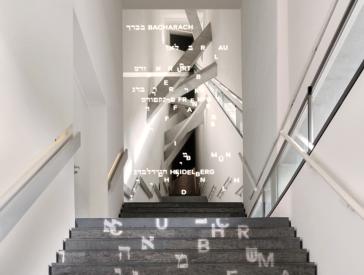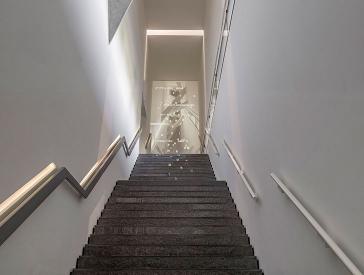Glückel in the Bowl
A Cooking Show as Part of Our Community Programming
Glückel is an imaginary kosher creature with a strong appetite. She’s easily bored, so she not only flew from Tel Aviv to Berlin in her flying bowl, but she’s now treating us to her a cooking show of her very own. In “Glückel in the Bowl,” she takes her viewers on a culinary journey through the diversity of Berlin’s kitchens. On the show, she cooks, bakes, and fries together with a wide range of families and communities. Get out your apron and cook along!
Who is Glückel?
Although Glückel was born in Tel Aviv, more than 80 Berliners from all age groups and cultural backgrounds were involved in designing her. They responded to an open call by the Community Programs of the Jewish Museum Berlin that posed the question “What would a Jewish imaginary creature look like?” The colorful designs served as inspiration for the Israeli puppet maker Maria Gurevich when she created Glückel as a theatrical puppet.
Glückel on a Cooking Tour of Our Communities’ Kitchens
Glückel is confused: "Wasn’t Easter last week?"
Well, yes and no! Orthodox Easter actually takes place one week later. Glückel joins Ukrainian families — including those with deeper German roots, as well as recent refugees — to bake Paska, a sweet bread eaten during Easter. It's not a coincidence that "Paska" sounds like "Passover," a Jewish holiday. The colorfully decorated Paska will receive a blessing from the priest; for this, Glückel accompanies her new friends to the Ukrainian church.
Paska Recipe
Ingredients
- 750ml milk
- 1/2 glass oil
- 2 kg flour
- 3 packets of dry yeast
- 150g raisins or dried cranberries
- 250g butter
- 300 g sugar
- 2 packets vanilla sugar
- 8 eggs
- 400g powdered sugar
- Colorful sprinkles and other decorations
- Paska molds
Directions
- Combine milk, yeast, 3 tbsp. sugar, 5 tbsp. flour, and yeast mixture and let rise for 20 minutes.
- Combine melted butter, eggs, sugar, vanilla sugar, cranberries, raisins, flour, and yeast mixture and let ferment for 30 minutes.
- Knead vigorously and let ferment again for 15 minutes.
- Fill the molds with the finished dough and bake in a preheated oven (180 degrees C) for about 30 minutes.
- Beat egg whites with 400g powdered sugar until foam forms, and spread over the cooled buns. Then decorate as desired.
Happy Easter! — щасливого Великодня!
The Lavarello family of Berlin-Wilmersdorf shows Glückel how to celebrate Easter in Italian — and the little blue goat is amazed at all the connections to the Jewish holiday of Passover. The cake is shaped like a dove, a symbol of peace – something that the world needs now. The Colomba di Pasqua cake represents not only the Holy Spirit, but also reconciliation and happiness!
Colomba di Pasqua recipe
Ingredients for the dough
- Colomba cake mold (750g)
- 6 eggs
- 200 g sugar
- 100g butter
- 1 orange
- 1 lemon
- 60g almonds
- 60g candied oranges
- 350g flour
- 150g milk
- 1 packet baking powder
- 50 g Amaretto di Saronno
Topping
- 100g granulated sugar
- 100g whole peeled almonds
Directions
Beat egg whites and let sit in the refrigerator. In a bowl, combine remaining ingredients and then carefully fold in the beaten egg whites. Then pour the batter into the Colomba cake mold.
Decorate, then bake in a preheated oven at 170°C for 50 minutes. Let cool before serving.
Buon appetito! Buona Pasqua!
This week, Glückel joins the Zuckermann family at Alexanderplatz. Things are lively in the pious family's home, yet everything is in perfect order. Purim is just around the corner, and Rabbi Nathan is showing his children an Esther Scroll. While Glückel and the children dress up and act out the Purim story, Orit, the mom, is already kneading the dough for the hamantaschen. Soon, a sweet aroma permeates the Zuckermann home, and everyone sings cheerful Purim songs.
Hamantaschen recipe
Ingredients for the dough
- 4 cups flour
- 1 cup sugar
- 1/3 cup oil
- 1/2 cups orange juice
- 100 g butter or margarine
- 4 eggs
- 1 packet baking powder
- 1 packet vanilla sugar
Fillings
- Poppy seed paste
- Plum butter
- Jam
- Nougat cream
Directions
Preheat oven to 190°C. In a bowl, combine dough ingredients and knead until smooth. Let dough sit in the fridge for 30 minutes. Then thinly roll the dough and cut out circles. Spoon 1 tsp. of filling onto each of the dough circles. Pinch three sides together to form a triangle. Bake the pastries at 190°C for 15 minutes until golden brown. Enjoy!
In our third episode, little Jewish Glückel visits the home of the Yang family as they’re about to start making jiaozi! These Chinese dumplings have many names, and are the Yang family’s favorite dish. On the Chinese New Year, the Yangs decorate their door with the Chinese character for "luck" — and as luck would have it, Glückel lands on their doorstep! The Yang family quickly warms to the blue goat. While Glückel and the Yang family discuss Chinese food and Jewish food rules, the jiaozi steam in the bamboo baskets. To celebrate the day, the children receive gifts of money. Glückel doesn’t leave empty-handed, either.
Jiaozi recipe
- Ingredients for the dough: 700g flour, 300–350ml water, 3–5 g salt
- Ingredients for the filling: 500g Chinese cabbage, 5 eggs, 5 shiitake mushrooms, 8–10 spring onions, 1 tsp sesame oil, 2 tsp canola oil, 3 tbsp soy sauce, 2 tsp five-spice powder, 1 tsp pepper, pinch of salt
For the filling: fry the eggs in a wok and break them into pieces, then mix them with the chopped shiitake mushrooms, spring onions, cabbage, spices, and oils.
For the dough: knead flour, water, and salt into dough. Using your hands, roll dough into balls. Then roll them flat with a rolling pin. Place filling in center of each dough circle and seal to form jiaozi.
Steam jiaozi in bamboo baskets for 12 minutes. Serve jiaozi with a variety of dips.
Enjoy!
On the longest night of the year, Glückel lands in Berlin-Spandau, where Sulmaz and her guests are celebrating the Persian Yalda night. On this night, according to ancient beliefs, a battle rages between light and darkness. Surrounded by joyous revelers, Glückel bakes pomegranate coins with a deep-red color that is reminiscent of the sun’s glow. With candlelight and symbolic dishes, Glückel is pampered — and also learns about the fortune-telling tradition involving Hafez poems.
In her dish, Glückel flies from Tel Aviv to Berlin and lands in the Eliasson family kitchen. There, daughter Leah and dad Boris are making latkes for Hanukkah. Glückel helps prepare the Jewish potato pancakes, shedding a few tears while chopping onions. While lighting the Hanukkah candles, Glückel is subjected to a hug-attack from little brother Aaron, who only lets go of Glückel once the latkes are served.

